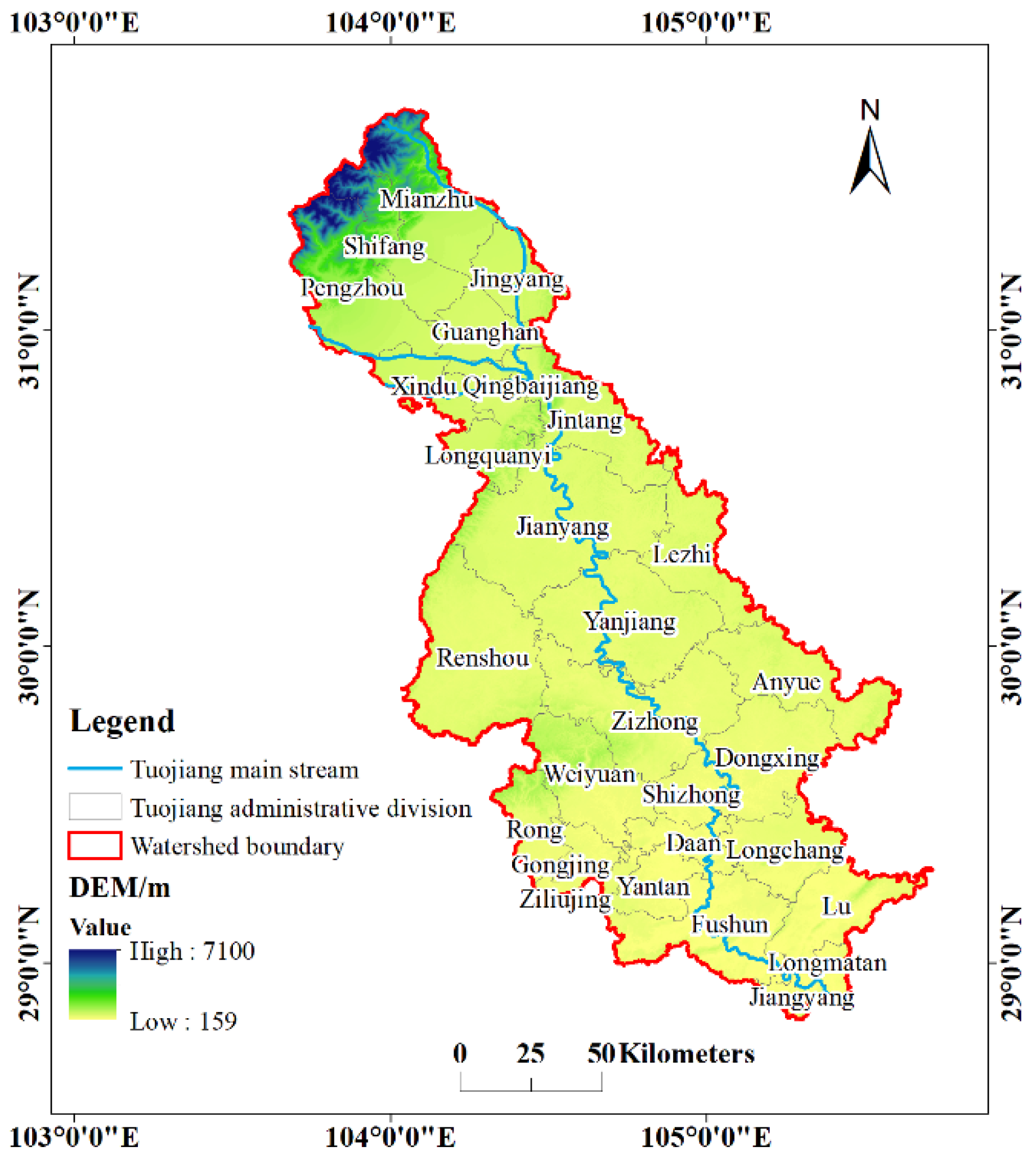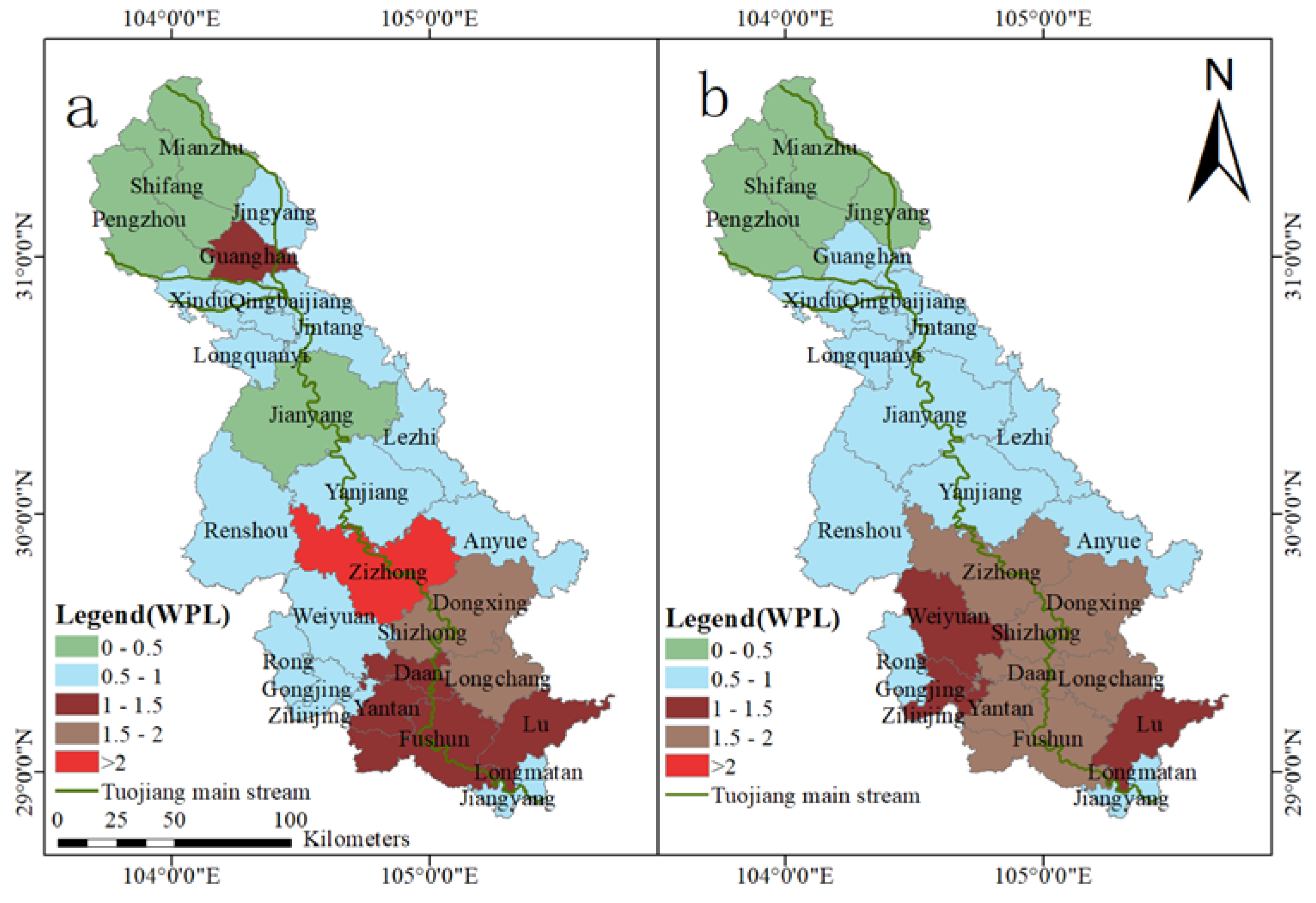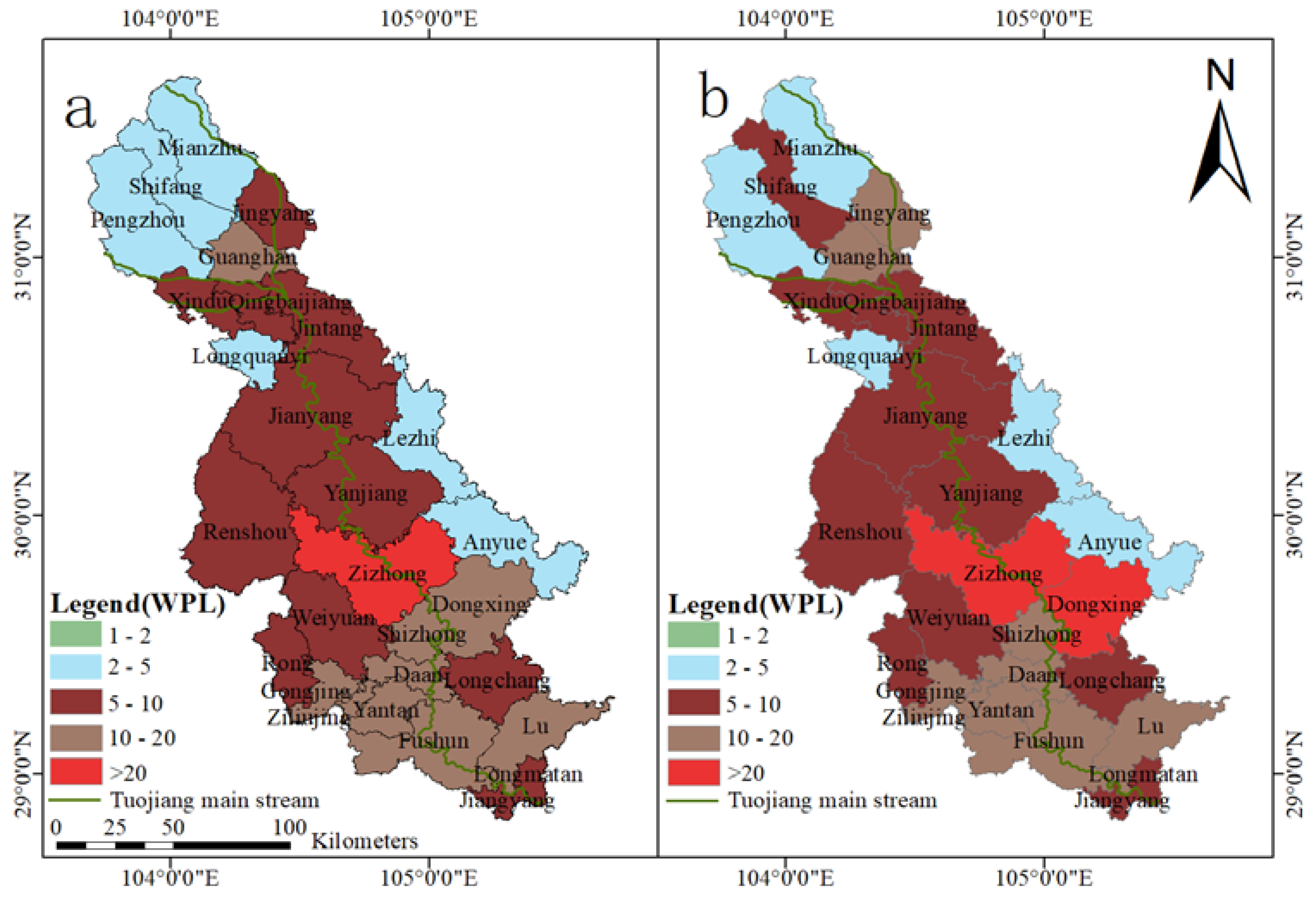Nitrogen and Phosphorus Loading Characteristics of Agricultural Non-Point Sources in the Tuojiang River Basin
Abstract
:1. Introduction
2. Material and Methods
2.1. Study Area
2.2. Data and Parameters
2.3. ANPS TN and TP Calculation
2.3.1. Planting Source
2.3.2. Rural Living Source
2.3.3. Poultry and Livestock Farming Source
2.4. Grey Water Footprint
3. Results
3.1. TN and TP Emissions from ANPS in the TJRB
3.1.1. TN and TP Emissions from Planting Source
3.1.2. TN and TP Emissions from Rural Living Source
3.1.3. TN and TP Emissions from Poultry and Livestock Farming Source
3.1.4. TN and TP Emissions from ANPS
3.2. GWF and WPL of ANPS in the TJRB
3.2.1. GWF and WPL of Planting Source
3.2.2. GWF and WPL of Rural Living Source
3.2.3. GWF and WPL of Poultry and Livestock Farming Source
3.2.4. GWF and WPL of ANPS
4. Discussion
4.1. TN and TP Loading Characteristics of ANPS
4.2. Damage to Water Quality of Tuojiang River by ANPS
4.3. Management Strategies and Recommendations
5. Conclusions
- (1)
- In 2018, the ANPS TN and TP loads in the TJRB totaled 60,888.92 tons and 20,085.98 tons, respectively. Subsequently, while TN loads decreased to 57,155.44 tons in 2019, TP loads increased to 21,659.91 tons. Among the districts and counties, Jianyang City, Renshou County, Dongxing District, and Zizhong County exhibited the heaviest ANPS TN and TP pollution, while Qingbaijiang District, Longquanyi District, Ziliujing District, and Longmatan District experienced relatively lighter ANPS TN and TP pollution levels. The distribution of ANPS TN and TP loads in the TJRB followed the pattern of being lowest in the upstream, intermediate in the downstream, and highest in the middle reaches.
- (2)
- Planting sources emerged as the primary contributors to TN and TP loads from ANPS in the TJRB, accounting for an average of 61.43% and 77.39%, respectively. In contrast, rural living sources and poultry and livestock farming sources made comparatively smaller contributions, with average percentages of 20.23% and 9.15% for TN loads and 18.34% and 13.46% for TP loads, respectively.
- (3)
- The analysis employing GWF and WPL indicators pointed to a continual rise in water environment pressure caused by TN and TP loads in the TJRB during the study period. Additionally, the WPL value of all the counties exceeded 1, indicating that the absorption capacity of the TJRB to the TN and TP loads from ANPS had been exhausted.
Supplementary Materials
Author Contributions
Funding
Informed Consent Statement
Data Availability Statement
Conflicts of Interest
References
- Wang, G.; Li, J.; Sun, W.; Xue, B.; Lan, A.Y.; Liu, T. Non-point source pollution risks in a drinking water protection zone based on remote sensing data embedded within a nutrient budget model. Water Res. 2019, 157, 238–246. [Google Scholar] [CrossRef]
- Zou, L.L.; Liu, Y.S.; Wang, Y.S.; Hu, X.D. Assessment and analysis of agricultural non-point source pollution loads in China: 1978–2017. J. Environ. Manag. 2020, 263, 110400. [Google Scholar] [CrossRef] [PubMed]
- Wang, C.; Zhang, H.; Xin, X.K.; Li, J.; Jia, H.Y.; Wen, L.Q.; Yin, W. Water level-driven agricultural nonpoint source pollution dominated the ammonia variation in China’s second largest reservoir. Environ. Res. 2022, 215, 114367. [Google Scholar] [CrossRef]
- Wang, M.; Zhang, Y.T.; Li, Q.C.; Jia, R.B.; Li, J.; Wang, Y.; Jiao, M. Simulation and optimal management of non-point source pollution in Zhaohe small watershed in Anhui province. Bull. Soil Water Conserv. 2017, 41, 127–136. (In Chinese) [Google Scholar]
- Guo, Y.Z.; Wang, X.Y.; Zhou, L.L.; Zheng, W.X. Configuration and efficiency evaluation of the best management practices to control nitrogen loss in the watershed. China Environ. Sci. 2021, 41, 860–871. (In Chinese) [Google Scholar]
- Xiang, S.; Wan, L.; Pang, Y. Spatial-temporal variation of inflow river water quality under land use effect. J. Agro-Environ. Sci. 2020, 39, 160–170. (In Chinese) [Google Scholar]
- Nguyen, K.T. Formal versus informal system to mitigate non-point source pollution: An experimental investigation. J. Agric. Econ. 2020, 71, 838–852. [Google Scholar] [CrossRef]
- Wu, Y.H.; Liu, J.Z.; Shen, R.F.; Fu, B. Mitigation of nonpoint source pollution in rural areas: From control to synergies of multi ecosystem services. Sci. Total Environ. 2017, 607–608, 1376–1380. [Google Scholar] [CrossRef]
- Xu, B.W.; Niu, Y.R.; Zhang, Y.N.; Chen, Z.F.; Zhang, L. China’s agricultural non-point source pollution and green growth: Interaction and spatial spillover. Environ. Sci. Pollut. Res. 2022, 29, 60278–60288. [Google Scholar] [CrossRef]
- Yan, R.; Li, L.; Gao, J. Framework for quantifying rural NPS pollution of a humid lowland catchment in Taihu Basin, eastern China. Sci. Total Environ. 2019, 688, 983–993. [Google Scholar] [CrossRef]
- Jiang, S.Y.; Hu, H.; Sheng, H.; Jarvie, H.P.; Liu, X.; Zhang, Y.; Yuan, Z.W.; Zhang, L.; Liu, X.W. Phosphorus footprint in China over the 1961–2050 period: Historical perspective and future prospect. Sci. Total Environ. 2019, 650, 687–695. [Google Scholar] [CrossRef] [PubMed]
- Liu, X.W.; Yuan, Z.W.; Liu, X.; Zhang, Y.; Hu, H.; Jiang, S.Y. Historic trends and future prospects of waste generation and recycling in China’s phosphorus cycle. Environ. Sci. Technol. 2020, 54, 5131–5139. [Google Scholar] [CrossRef] [PubMed]
- Yuan, Z.W.; Pang, Y.J.; Gao, J.Q.; Liu, X.; Sheng, H.; Zhuang, Y.J. Improving quantification of rainfall runoff pollutant loads with consideration of path curb and field ridge. Resour. Environ. Sustain. 2021, 6, 100042. [Google Scholar] [CrossRef]
- Xue, B.L.; Zhang, H.W.; Wang, G.Q.; Sun, W.C. Evaluating the risks of spatial and temporal changes in nonpoint source pollution in a Chinese river basin. Sci. Total Environ. 2022, 807, 151726. [Google Scholar] [CrossRef]
- Chahor, Y.; Casalí, J.; Gimenez, R.; Bingner, R.L.; Campo, M.A.; Goni, M. Evaluation of the AnnAGNPS model for predicting runoff and sediment yield in a small mediterranean agricultural watershed in Navarre (Spain). Agric. Water Manag. 2014, 134, 24–37. [Google Scholar] [CrossRef]
- Chen, Y.H.; Wen, X.W.; Wang, B.; Nie, P.Y. Agricultural pollution and regulation: How to subsidize agriculture. J. Clean. Prod. 2017, 164, 258–264. [Google Scholar] [CrossRef]
- Xie, X.; Fang, B.; Xu, H.Z.; He, S.S.; Xin, L. Study on the coordinated relationship between Urban Land use efficiency and ecosystem health in China. Land Use Policy 2021, 102, 105235. [Google Scholar] [CrossRef]
- Li, L.; Gou, M.; Wang, N.; Ma, W.; La, L. Landscape configuration mediates hydrology and nonpoint source pollution under climate change and agricultural expansion. Ecol. Indic. 2021, 129, 107959. [Google Scholar] [CrossRef]
- Peng, J.Y.; Tong, H.J.; Liu, X.C.; Feng, Y.; Zhu, Y.M.; Wu, Y.; Chu, Z.S.; Zheng, B.H. Comprehensive evaluation of water resources and environmental carrying capacity based on dualistic water cycle analysis and its application in the Tuo River Basin, China. Ecol. Indic. 2023, 146, 109897. [Google Scholar] [CrossRef]
- Fu, D.; Wu, X.F.; Chen, Y.C.; Yi, Z.Y. Spatial variation and source apportionment of surface water pollution in the Tuo River, China, using multivariate statistical techniques. Environ. Monit. Assess. 2020, 192, 745. [Google Scholar] [CrossRef]
- Cui, M.; Guo, Q.J.; Wei, R.F.; Wei, Y.J. Anthropogenic nitrogen and phosphorus inputs in a new perspective: Environmental loads from the mega economic zone and city clusters. J. Clean. Prod. 2020, 283, 124589. [Google Scholar] [CrossRef]
- Liu, D.D.; Bai, L.; Qiao, Q.; Zhang, Y.; Li, X.Y.; Zhao, R.N.; Liu, J.Y. Anthropogenic total phosphorus emissions to the Tuojiang River Basin, China. J. Clean. Prod. 2021, 294, 126325. [Google Scholar] [CrossRef]
- Wang, H.; Xu, Y.L.; Zhang, Q.; Lin, C.W.; Zhai, L.M.; Liu, H.T.; Pu, B. Emission characteristics of nitrogen and phosphorus in a typical agricultural small watershed in Tuojiang River Basin. Environ. Sci. 2020, 41, 4547–4554. (In Chinese) [Google Scholar]
- Acosta, A.B.; Chu, M.L.; Huang, C. Impacts of environmental stressors on nonpoint source pollution in intensively managed hydrologic systems. J. Hydrol. 2019, 579, 124056. [Google Scholar] [CrossRef]
- Zhao, H.Y.; Piccone, T. Large scale constructed wetlands for phosphorus removal, an effective nonpoint source pollution treatment technology. Ecol. Eng. 2020, 145, 105711. [Google Scholar] [CrossRef]
- Green, L.; Magel, C.; Brown, C. Management pathways for the successful reduction of nonpoint source nutrients in coastal ecosystems. Reg. Stud. Mar. Sci. 2021, 45, 101851. [Google Scholar] [CrossRef]
- Chapagain, A.K.; Hoekstra, A.Y.; Savenije, H.H.G.; Gautam, R. The water footprint of cotton consumption: An assessment of the impact of worldwide consumption of cotton products on the water resources in the cotton producing countries. Ecol. Econ. 2006, 60, 186–203. [Google Scholar] [CrossRef]
- Karandish, F. Applying grey water footprint assessment to achieve environmental sustainability within a nation under intensive agriculture: A high-resolution assessment for common agrochemicals and crops. Environ. Earth Sci. 2019, 78, 200. [Google Scholar] [CrossRef]
- Miglietta, P.P.; Toma, P.; Fanizzi, F.P.; Donno, A.; Coluccia, B.; Migoni, D.; Bagordo, F.; Serio, F. A Grey water footprint assessment of groundwater chemical pollution: Case study in Salento (southern Italy). Sustainability 2017, 9, 799. [Google Scholar] [CrossRef]
- Zhao, X.; Liao, X.; Chen, B.; Tillotson, M.R.; Guo, W.; Li, Y. Accounting global grey water footprint from both consumption and production perspectives. J. Clean. Prod. 2019, 225, 963–971. [Google Scholar] [CrossRef]
- Aldaya, M.M.; Rodriguez, C.I.; Fernandez-Poulussen, A.; Merchan, D.; Beriain, M.J.; Llamas, R. Grey water footprint as an indicator for diffuse nitrogen pollution: The case of Navarra, Spain. Sci. Total Environ. 2020, 698, 134338. [Google Scholar] [CrossRef] [PubMed]
- Hoekstra, A.Y.; Mekonnen, M.M. The water footprint of humanity. Proc. Natl. Acad. Sci. USA 2012, 109, 3232–3237. [Google Scholar] [CrossRef] [PubMed]
- Feng, H.Y.; Sun, F.Y.; Liu, Y.Y.; Zeng, P.; Deng, L.Z.; Che, Y. Mapping multiple water pollutants across China using the grey water footprint. Sci. Total Environ. 2021, 785, 147255. [Google Scholar] [CrossRef]
- Yu, C.X.; Yin, X.N.; Li, H.; Yang, Z.F. A hybrid water-quality-index and grey water footprint assessment approach for comprehensively evaluating water resources utilization considering multiple pollutants. J. Clean. Prod. 2020, 742, 140553. [Google Scholar] [CrossRef]
- Muratoglu, A. Grey water footprint of agricultural production: An assessment based on nitrogen surplus and high-resolution leaching runoff fractions in Turkey. Sci. Total Environ. 2020, 785, 147255. [Google Scholar] [CrossRef]
- Zhang, Y.; Liu, X.J.; You, L.Z.; Zhang, F.S. Improving potential of nitrogen linked gray water footprint in China’s intensive cropping systems. J. Clean. Prod. 2020, 269, 122307. [Google Scholar] [CrossRef]
- Fu, D.; Chen, S.; Chen, Y.C.; Yi, Z.Y. Development of modified integrated water quality index to assess the surface water quality: A case study of Tuo River, China. Environ. Monit. Assess. 2022, 194, 333. [Google Scholar] [CrossRef] [PubMed]
- Xiao, Y.T.; Chen, S.; Fan, M. Temporally and Spatially varied characteristics of pollution load in Tuojiang River Basin. Acta Sci. Circumstantiae 2021, 41, 1981–1995. (In Chinese) [Google Scholar]
- Xiao, Y.T.; Yao, J.; Chen, S.; Fan, M. Temporal and spatial evolution of non-point source pollution load of total nitrogen in Tuojiang River Basin. Environ. Sci. 2021, 42, 3773–3784. (In Chinese) [Google Scholar]
- Zhang, W.Q.; Jin, X.; Cao, H.M.; Zhao, Y.; Shan, B.Q. Water quality in representative tuojiang river network in southwest China. Water 2018, 10, 864. [Google Scholar] [CrossRef]
- Yan, K.; Xu, J.C.; Gao, W.; Li, M.J.; Yuan, Z.W.; Zhang, F.S.; Elser, J. Human perturbation on phosphorus cycles in one of China’s most eutrophicated lakes. Resour. Environ. Sustain. 2021, 4, 100026. [Google Scholar] [CrossRef]
- Yan, K.; Yuan, Z.W.; Goldberg, S.; Gao, W.; Ostermann, A.; Xu, J.C.; Zhang, F.S.; Elser, J. Phosphorus mitigation remains critical in water protection: A review and meta-analysis from one of China’s most eutrophicated lakes. Sci. Total Environ. 2019, 689, 1336–1347. [Google Scholar] [CrossRef] [PubMed]
- National Bureau of Statistics of China. Sichuan Statistical Yearbook; China Statistics Press: Beijing, China, 2019; Available online: https://www.chinayearbooks.com/sichuan-statistical-yearbook-2019.html (accessed on 2 October 2023). (In Chinese)
- National Bureau of Statistics of China. Sichuan Statistical Yearbook; China Statistics Press: Beijing, China, 2020; Available online: https://www.chinayearbooks.com/sichuan-statistical-yearbook-2020.html (accessed on 2 October 2023). (In Chinese)
- Changjiang Water Resources Commission of the Ministry of Water Resources. Changjiang and Southwest Rivers Water Resources Bulletin, 1st ed.; ChangJiang Press: Wuhan, China, 2019. (In Chinese) [Google Scholar]
- Changjiang Water Resources Commission of the Ministry of Water Resources. Changjiang and Southwest Rivers Water Resources Bulletin, 2nd ed.; ChangJiang Press: Wuhan, China, 2020. (In Chinese) [Google Scholar]
- China Pollution Source Census. Handbook of Emission Factors of Domestic Pollution Sources for the Second National Pollution Source Census; China Water Risk: Hong Kong, China, 2019. (In Chinese) [Google Scholar]
- Guo, X.X.; Zhang, H.; Yang, R.X. Pollutant loads and environmental risks of livestock production based on arable land carrying capacity—A case study in Sichuan Province. Bull. Soil Water Conserv. 2019, 39, 226–232. (In Chinese) [Google Scholar]
- Yang, J.; Wang, Y.D.; Fang, S.Q.; Qiang, Y.F.; Liang, J.P.; Yang, G.H.; Feng, Y.Z. Evaluation of livestock pollution and its effects on a water source protection area in China. Environ. Sci. Pollut. Res. 2020, 27, 18632–18639. [Google Scholar] [CrossRef]
- Department of Ecology and Environment Sichuan Province. Sichuan Ecology and Environment Statement 2019; Department of Ecology and Environment Sichuan Province: Chengdu, China, 2020. (In Chinese) [Google Scholar]
- Qi, X.Y. Estimation and Assessment of Diffused Pollution Load in Upper Reaches of Liao River. Master’s Thesis, LiaoNing University, Shenyang, China, 2019. (In Chinese). [Google Scholar]
- Chen, H.; Teng, Y.; Wang, J. Load estimation and source apportionment of nonpoint source nitrogen and phosphorus based on integrated application of SLURP model, ECM, and RUALE-a case study in the Jinjiang River, China. Environ. Monit. Assess. 2013, 185, 2009–2021. [Google Scholar] [CrossRef]
- Wu, L.; Gao, J.E.; Ma, X.Y.; Li, D. Application of modified export coefficient method on the load estimation of non-point source nitrogen and phosphorus pollution of soil and water loss in semiarid regions. Environ. Sci. Pollut. Res. 2015, 22, 10647–10660. [Google Scholar] [CrossRef]
- Hoekstra, A.Y.; Chapagain, A.K.; Aldaya, M.M.; Mekonnen, M.M. The Water Footprint Assessment Manual: Setting the Global Standard; Earthscan: London, UK, 2011. [Google Scholar]
- Powers, S.M.; Bruulsema, T.W.; Burt, T.P.; Chan, N.I.; Elser, J.J.; Haygarth, P.M.; Howden, N.J.K.; Jarvie, H.P.; Lyu, Y.; Peterson, H.M.; et al. Long-term accumulation and transport of anthropogenic phosphorus in three river basins. Nat. Geosci. 2016, 9, 353. [Google Scholar] [CrossRef]
- Hu, Y.; Long, C.M.; Wang, Y.C.; Kerkez, B.; Scavia, D. Urban total phosphorus loads to the st. Clair-detroit river system. J. Great Lakes Res. 2019, 45, 1142–1149. [Google Scholar] [CrossRef]












| Emission Coefficient of TN (g/Head Day) | Loss Coefficient into the River of TN (%) | Emission Coefficient of TP (g/Head Day) | Loss Coefficient into the River of TP (%) | |
|---|---|---|---|---|
| Swine | 19.74 | 5.25 | 4.84 | 5.25 |
| Cattle | 104.1 | 5.68 | 10.17 | 5.5 |
| Sheep | 14.91 | 5.3 | 1.99 | 5.2 |
| Poultry | 0.96 | 8.47 | 0.15 | 8.42 |
Disclaimer/Publisher’s Note: The statements, opinions and data contained in all publications are solely those of the individual author(s) and contributor(s) and not of MDPI and/or the editor(s). MDPI and/or the editor(s) disclaim responsibility for any injury to people or property resulting from any ideas, methods, instructions or products referred to in the content. |
© 2023 by the authors. Licensee MDPI, Basel, Switzerland. This article is an open access article distributed under the terms and conditions of the Creative Commons Attribution (CC BY) license (https://creativecommons.org/licenses/by/4.0/).
Share and Cite
Fu, D.; Gong, Y.; Chen, C.; Gui, X.; Liu, H.; Chen, S.; Ren, J.; Hou, B. Nitrogen and Phosphorus Loading Characteristics of Agricultural Non-Point Sources in the Tuojiang River Basin. Water 2023, 15, 3503. https://doi.org/10.3390/w15193503
Fu D, Gong Y, Chen C, Gui X, Liu H, Chen S, Ren J, Hou B. Nitrogen and Phosphorus Loading Characteristics of Agricultural Non-Point Sources in the Tuojiang River Basin. Water. 2023; 15(19):3503. https://doi.org/10.3390/w15193503
Chicago/Turabian StyleFu, Dong, Yanchuan Gong, Chuntan Chen, Xiao Gui, Hepei Liu, Shu Chen, Juntao Ren, and Bingjie Hou. 2023. "Nitrogen and Phosphorus Loading Characteristics of Agricultural Non-Point Sources in the Tuojiang River Basin" Water 15, no. 19: 3503. https://doi.org/10.3390/w15193503
APA StyleFu, D., Gong, Y., Chen, C., Gui, X., Liu, H., Chen, S., Ren, J., & Hou, B. (2023). Nitrogen and Phosphorus Loading Characteristics of Agricultural Non-Point Sources in the Tuojiang River Basin. Water, 15(19), 3503. https://doi.org/10.3390/w15193503





